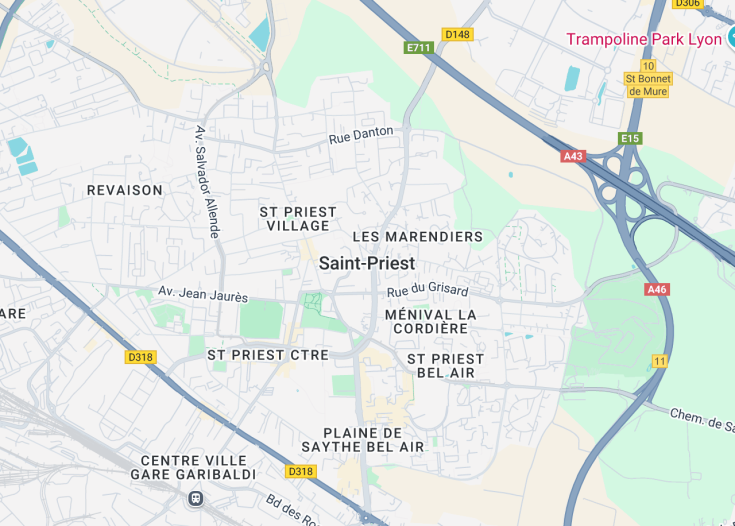Saint-Priest, a commune in the Auvergne-Rhône-Alpes region of southeastern France, offers a rich tapestry of cultural and historical assets. This suburban town, located on the outskirts of Lyon, blends modern amenities with timeless charm. Visitors can explore beautiful parks, historic castles, and local festivals that exhibit Saint-Priest’s lively community spirit. The area’s strategic position also makes it an ideal base for exploring the broader Lyon metropolis and its surrounding natural landscapes.
When visiting Saint-Priest, ensure you spend an afternoon exploring the Château de Saint-Priest, an architectural marvel with beautifully landscaped gardens.
Plan your trip to coincide with one of Saint-Priest’s traditional festivals for a true taste of local culture and festivity, enriching your travel experience.
Top things to do & see in Saint-Priest
Select the following sights and activities to discover best tickets and tours available in Saint-Priest.
Saint-Priest: A Hidden Gem in France
| Country | France |
| Time in Saint-Priest | GMT+1 |
| Language spoken | French |
| Population | 42,535 (source: INSEE, 2023) |
| Currency | Euro (€, EUR) |
| Airports |
|
Saint-Priest, a suburb of Lyon in eastern France, is often overshadowed by its prominent neighbor but offers a rich blend of history and modernity that speaks to its distinct character. Nestled in the Auvergne-Rhône-Alpes region, Saint-Priest was once a sleepy agricultural town but has transformed significantly over the decades. Today, it is a thriving municipality that harmoniously blends industrial activity with residential calm.
The roots of Saint-Priest stretch back to medieval times, and it retains a charming old village at its heart, where narrow lanes and old stone houses whisper tales of yesteryears. The centerpiece is the Château de Saint-Priest, which dates back to the 16th century and adds a touch of historical grandeur to the area.
In recent decades, Saint-Priest has embraced modernization while protecting its environmental heritage. It has become a hub for business and commerce, hosting a myriad of companies within its numerous business parks. This economic boom has brought about improvements in local infrastructure, making Saint-Priest a convenient and attractive place to live.
The locality is also popular for its vibrant cultural scene, including several sport facilities, libraries, and cultural centers that host a variety of events throughout the year. Saint-Priest also places a strong emphasis on community and social cohesion, where markets and festivals often animate the heart of the city, fostering a strong sense of community among residents.
Whether one is drawn to its historical roots or its modern-day amenities, Saint-Priest offers a unique slice of French life that combines tradition with the momentum of contemporary development.
Where is Saint-Priest?
Saint-Priest is situated in the eastern part of France, near Lyon in the Auvergne-Rhône-Alpes region.
Distances:
| Route | Distance by car | Time by car |
|---|---|---|
| Lyon to Saint-Priest | 8.5 miles (13.7 km) | 20 minutes |
| Grenoble to Saint-Priest | 60 miles (96.5 km) | 1 hour 10 minutes |
| Saint-Étienne to Saint-Priest | 50 miles (80 km) | 1 hour |
What is Saint-Priest famous for?
Saint-Priest is renowned for its historic château and beautifully preserved old village, offering a picturesque window into France’s rich past alongside a vibrant community life.
History
The history of Saint-Priest, a charming commune in the Auvergne-Rhône-Alpes region of France, is a fascinating journey through time, from ancient settlements to its current status as a vibrant suburban community. This historical synopsis explores critical periods in the development of Saint-Priest.
Pre-History to Medieval Times (Before 1000 AD – 15th Century)
Archeological findings suggest the area around Saint-Priest was inhabited in prehistoric times. However, the most substantial historical records begin with the Roman occupation, during which the area was known primarily for agriculture. By the medieval period, Saint-Priest emerged as a small settlement. The construction of its first church marks its significance during this era, serving both religious and social gathering purposes for the local populace.
Renaissance to French Revolution (15th Century – 18th Century)
The Renaissance brought about significant changes in the architecture and culture of Saint-Priest, with the construction of several stately homes indicating its residents’ growing wealth. During the 17th and 18th centuries, the area was notable for its agricultural production. The societal structure of Saint-Priest saw dramatic changes leading up to and during the French Revolution, as local governance structures were influenced heavily by the shifting political landscape of France.
Industrialization to Modern Day (19th Century – 21st Century)
The 19th century ushered in the Industrial Revolution, which significantly affected Saint-Priest. The introduction of railway lines improved connectivity, stimulating local industry and economic growth. Throughout the 20th and into the 21st century, Saint-Priest has seen extensive urban development, transforming from a primarily rural community to a suburban area enriched with cultural diversity. Today, the city balances modernity with its rich historical heritage, making it a unique blend of the old and new.
Visit Saint-Priest
What to see and do in Saint-Priest
Exploring Saint-Priest offers a delightful experience for visitors. One can start at the Château de Saint-Priest, an 18th-century castle with beautifully maintained grounds, perfect for leisurely walks. The town’s center, with its quaint streets and local shops, provides a taste of French suburban life.
For nature enthusiasts, the Parc du Fort offers sprawling green spaces and sports facilities. Art lovers should not miss the modern installations at the Urban Art Gallery.
- Visit the Château de Saint-Priest and its gardens.
- Stroll through the historic town center.
- Relax or play sports at Parc du Fort.
- View contemporary art at the Urban Art Gallery.
Annual Celebrations in Saint-Priest
Saint-Priest hosts a variety of events throughout the year, celebrating its rich culture and community spirit. The “Fête de la Musique” in June fills the streets with music of all genres, attracting performers and audiences alike.
In September, the “Festival of Colors” brightens the town with vibrant displays and activities centered around art and diversity. Additionally, the Christmas market in December offers festive treats and gifts, drawing visitors into the holiday spirit.
Best time to visit Saint-Priest
The best time to visit Saint-Priest is late spring through early autumn, from May to September, when the weather is most pleasant. This period provides an excellent opportunity for outdoor activities and enjoying the local events that take place.
Is Saint-Priest worth visiting?
Saint-Priest, with its rich blend of history and modernity, offers a compelling destination for those intrigued by French culture and history. The beautifully preserved Château de Saint-Priest and the vibrant local events provide unique attractions.
However, those seeking a bustling city experience may find it quieter than France’s major urban centers. Accessibility might also pose a challenge for international tourists without personal transport. Overall, Saint-Priest is worth visiting for those interested in a quieter, culturally rich French experience.









